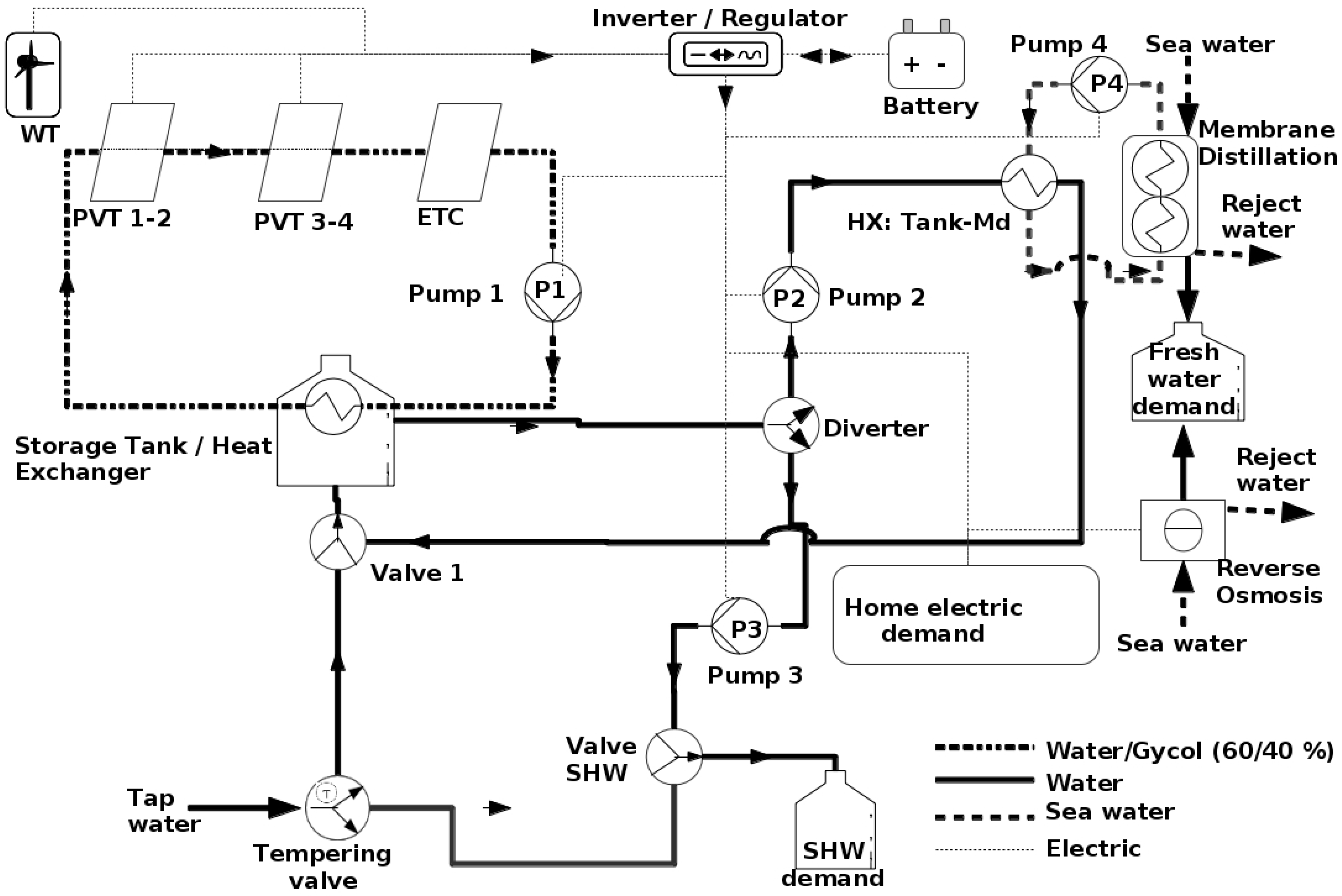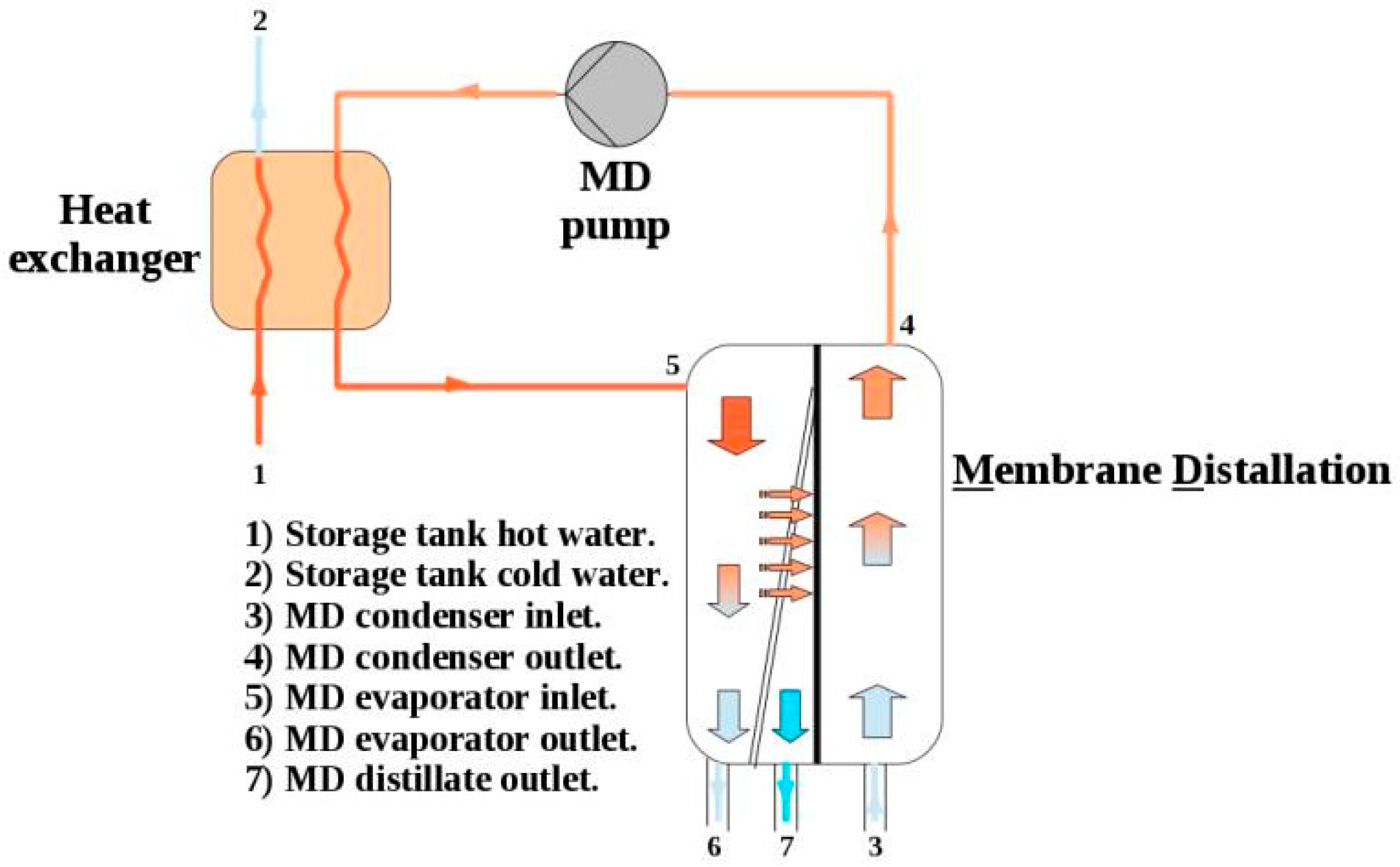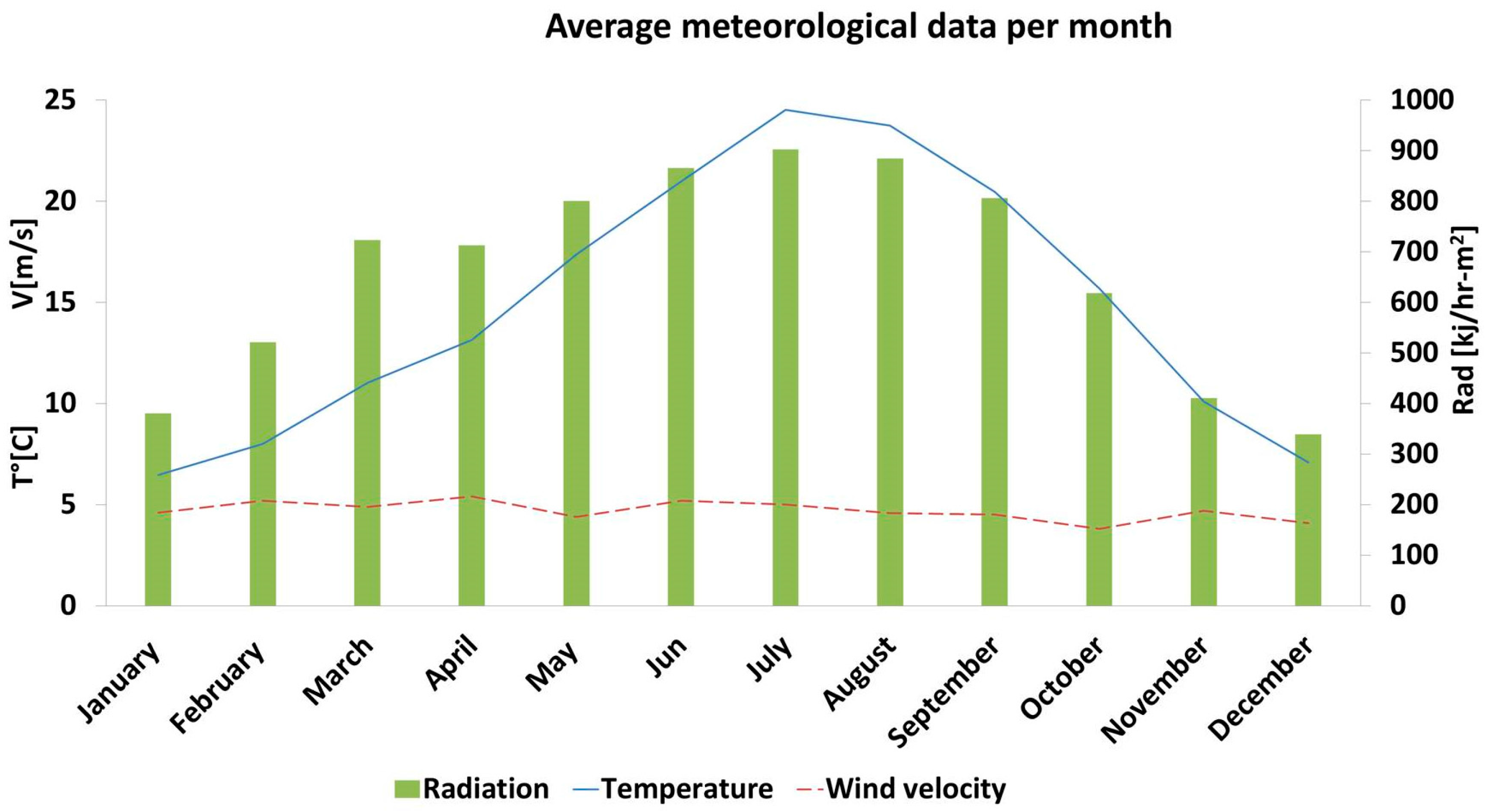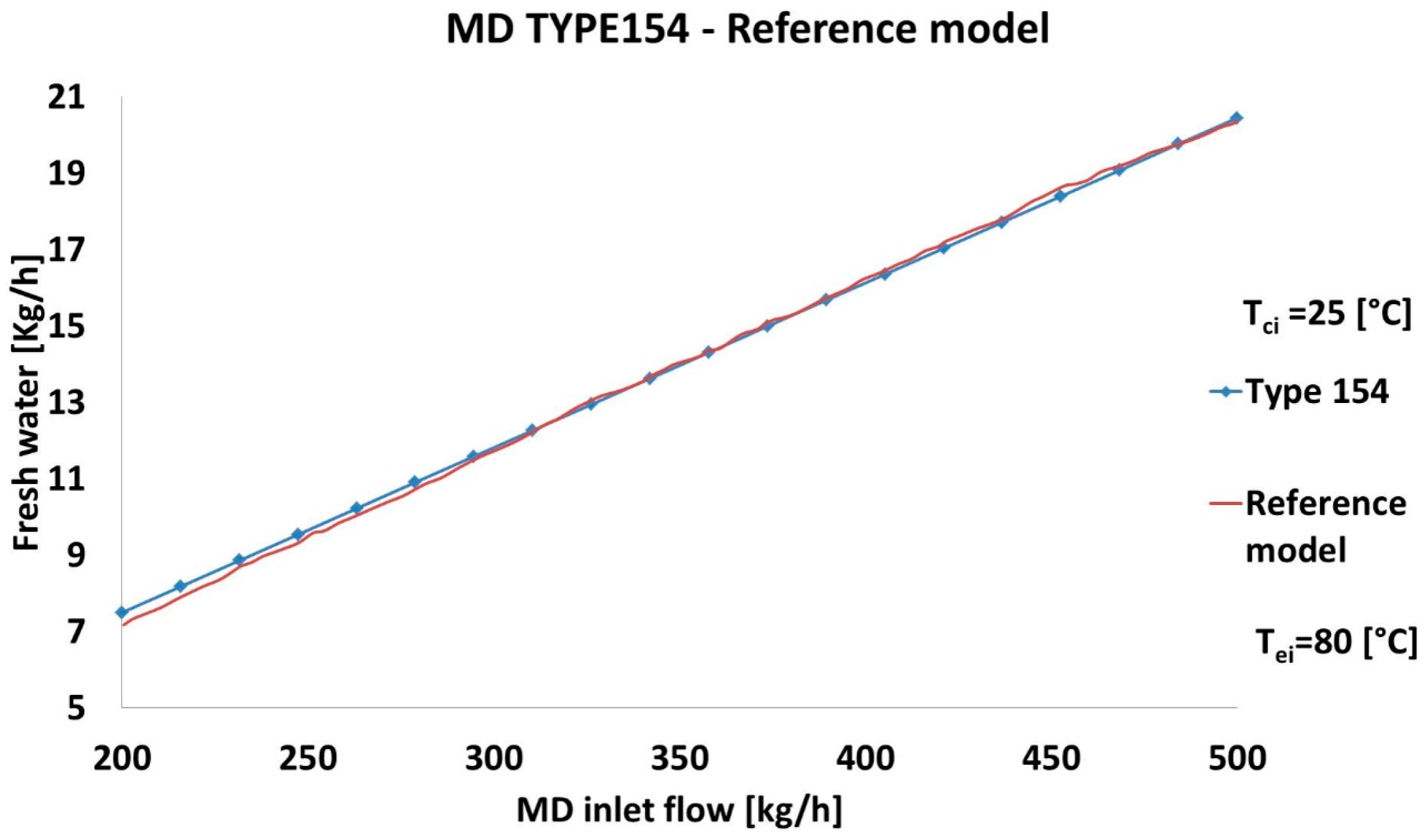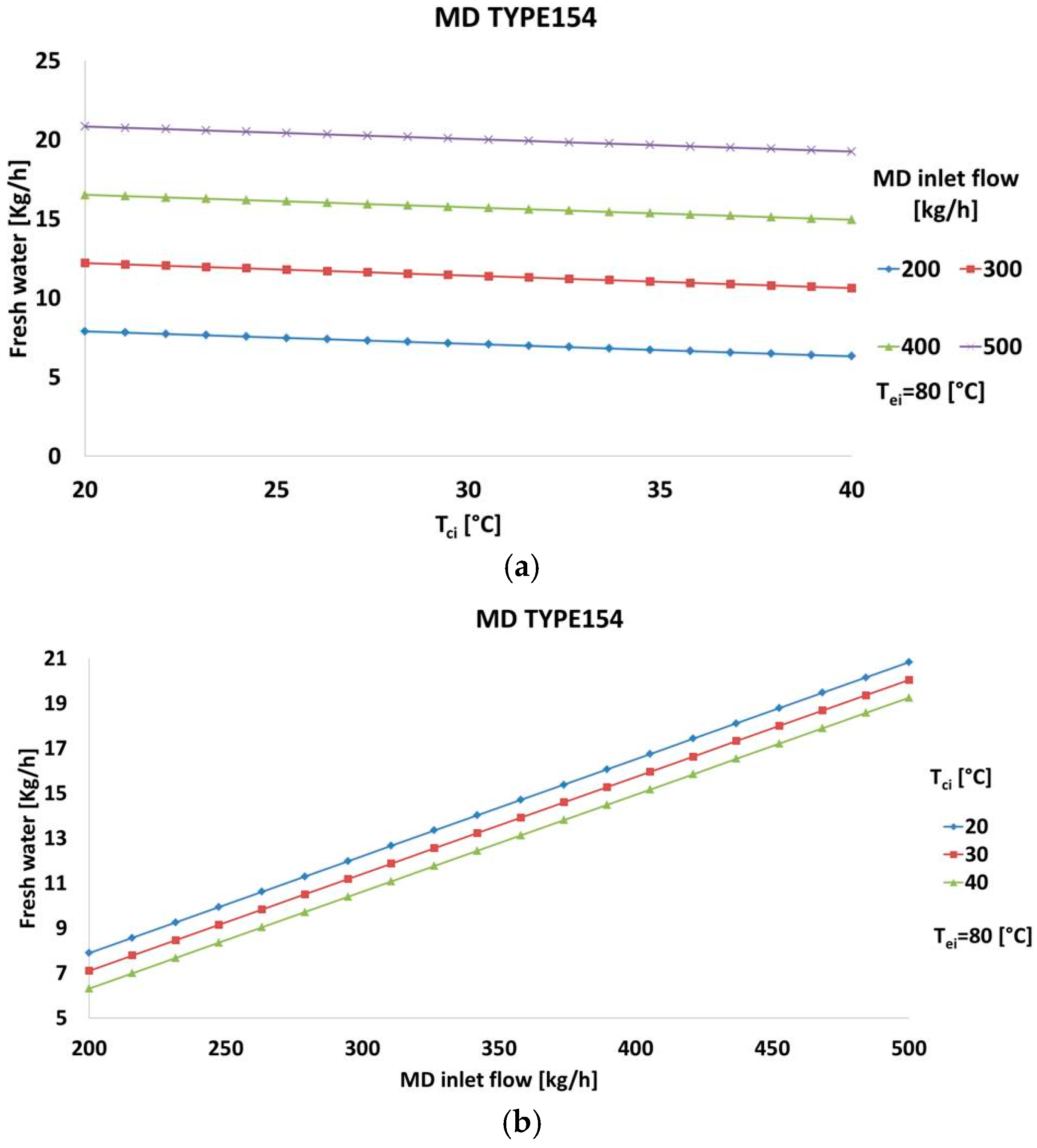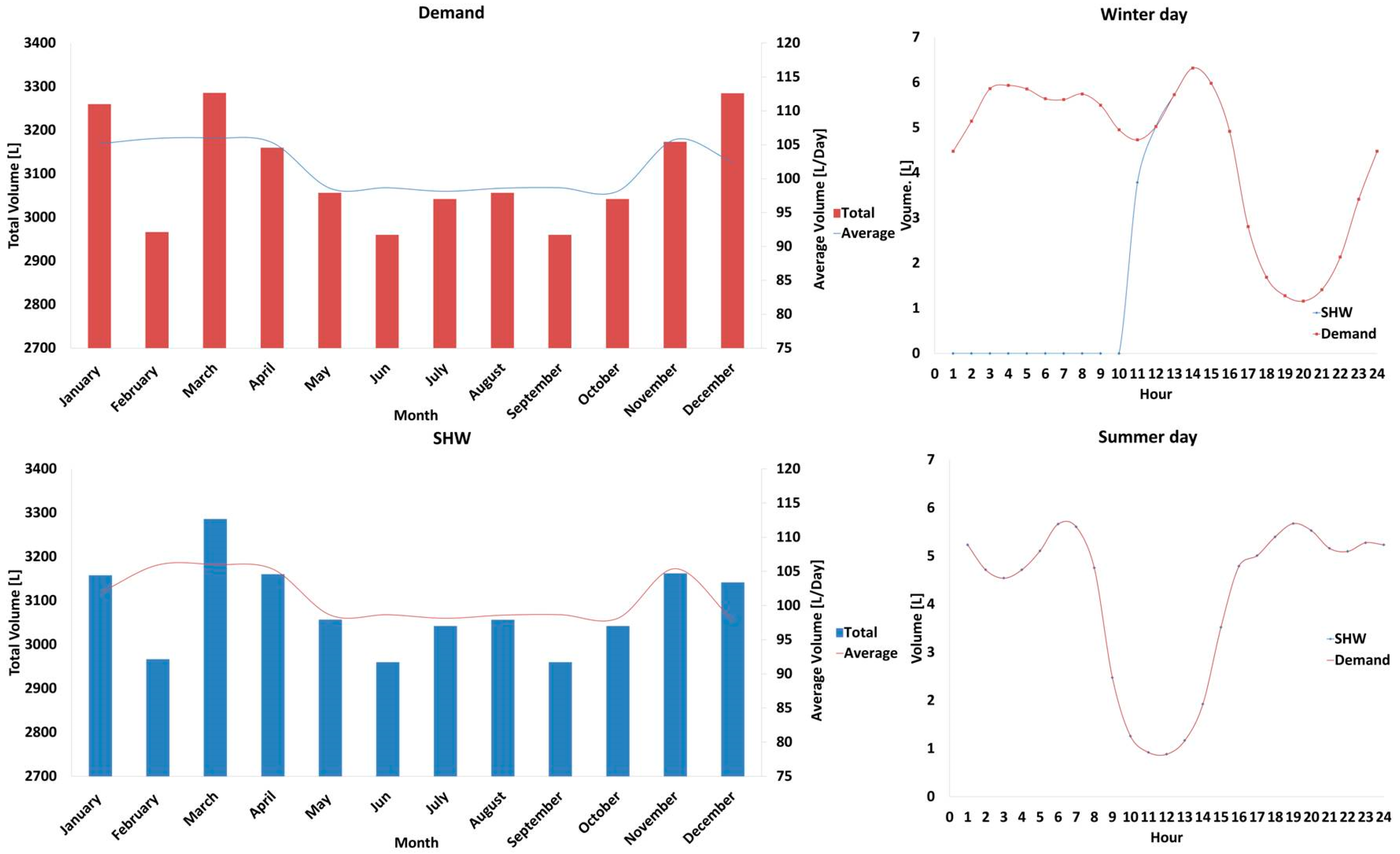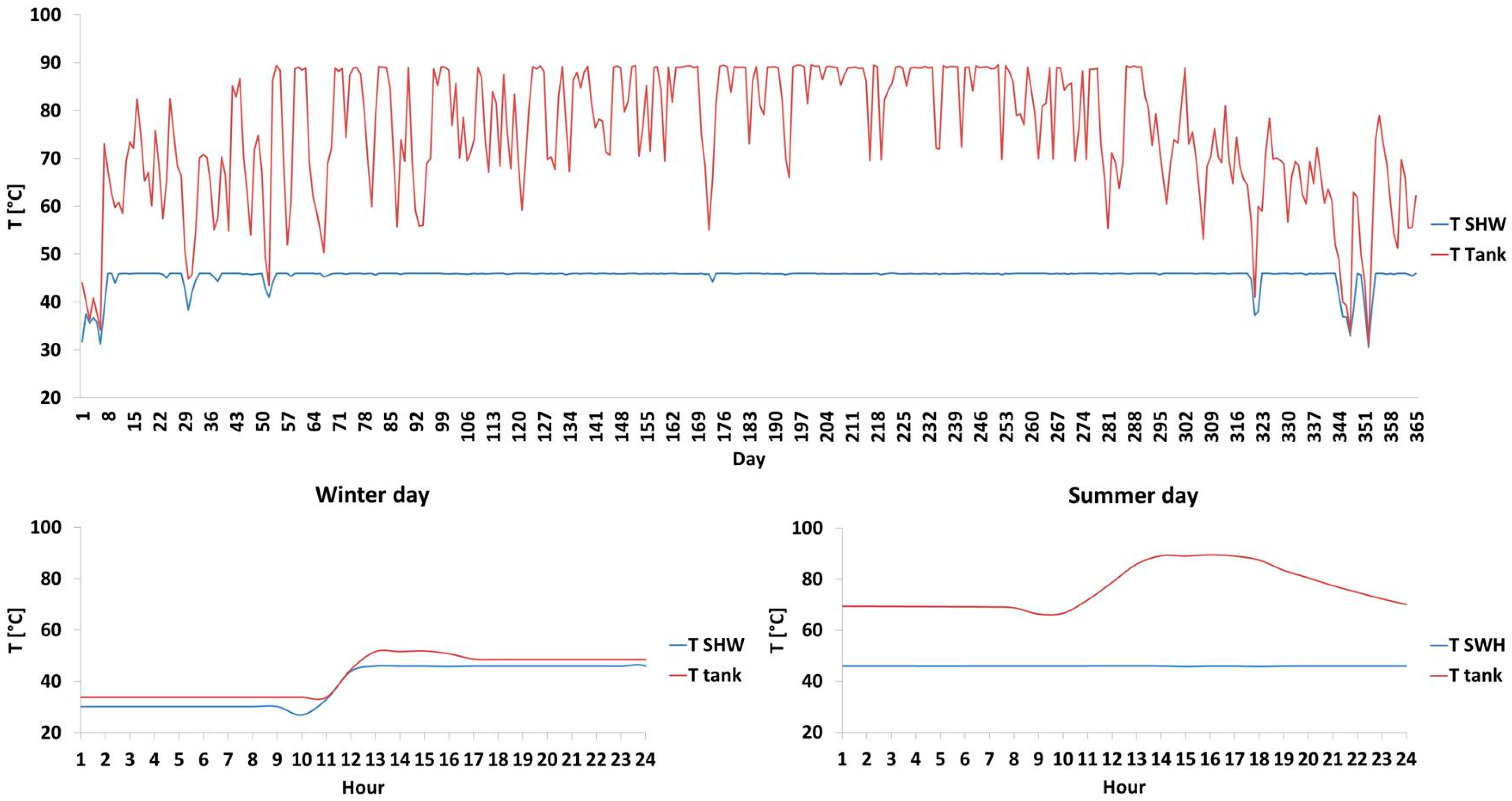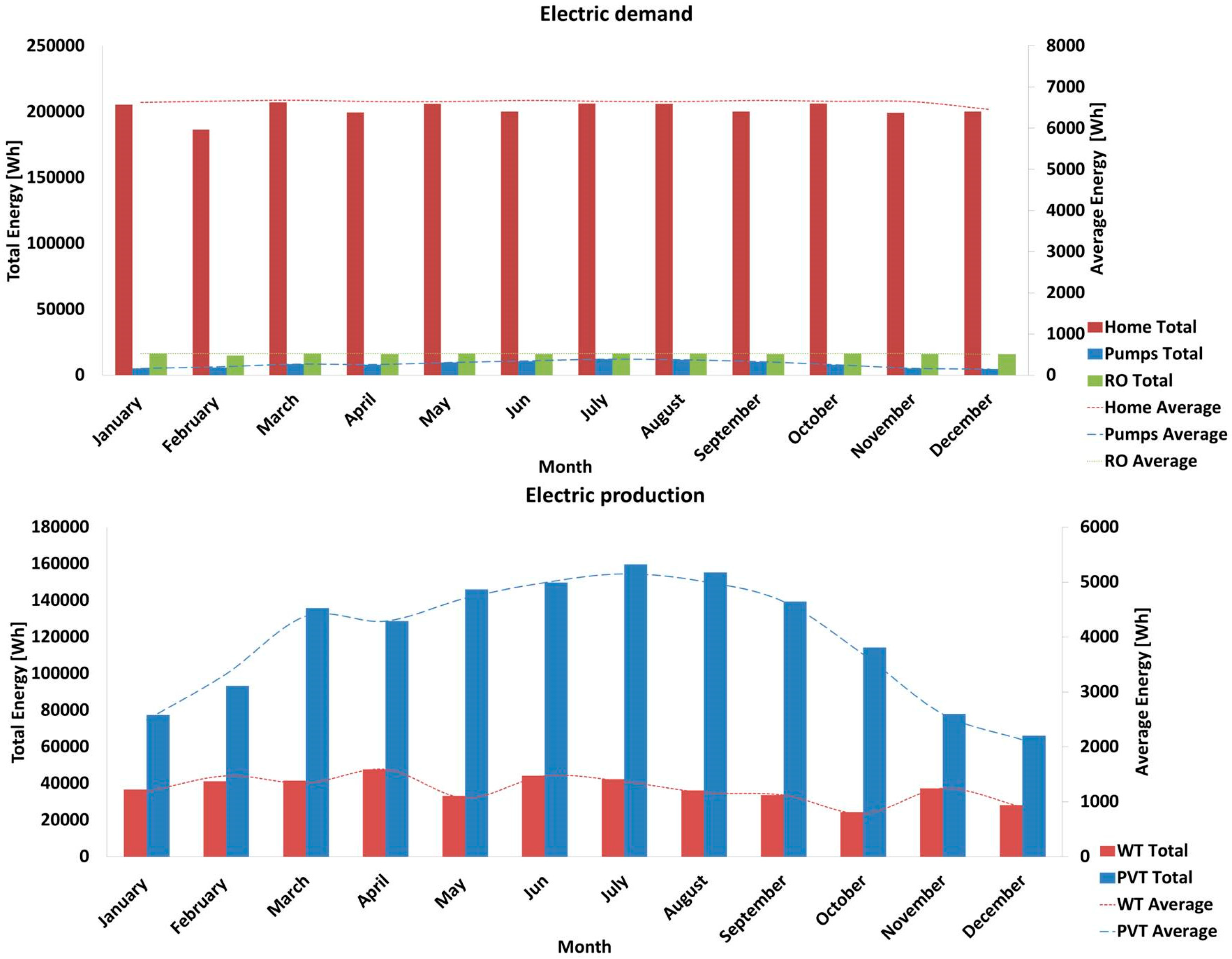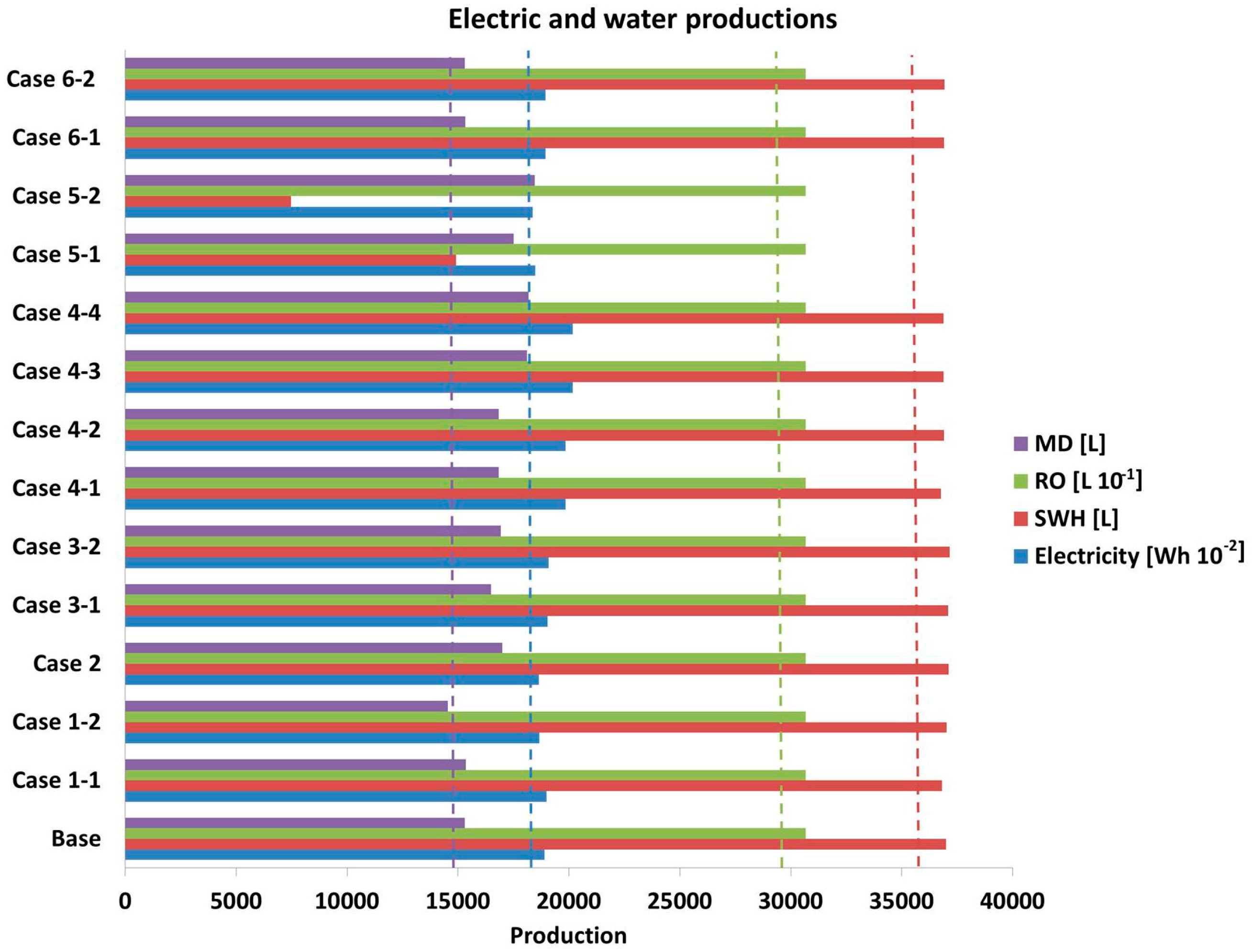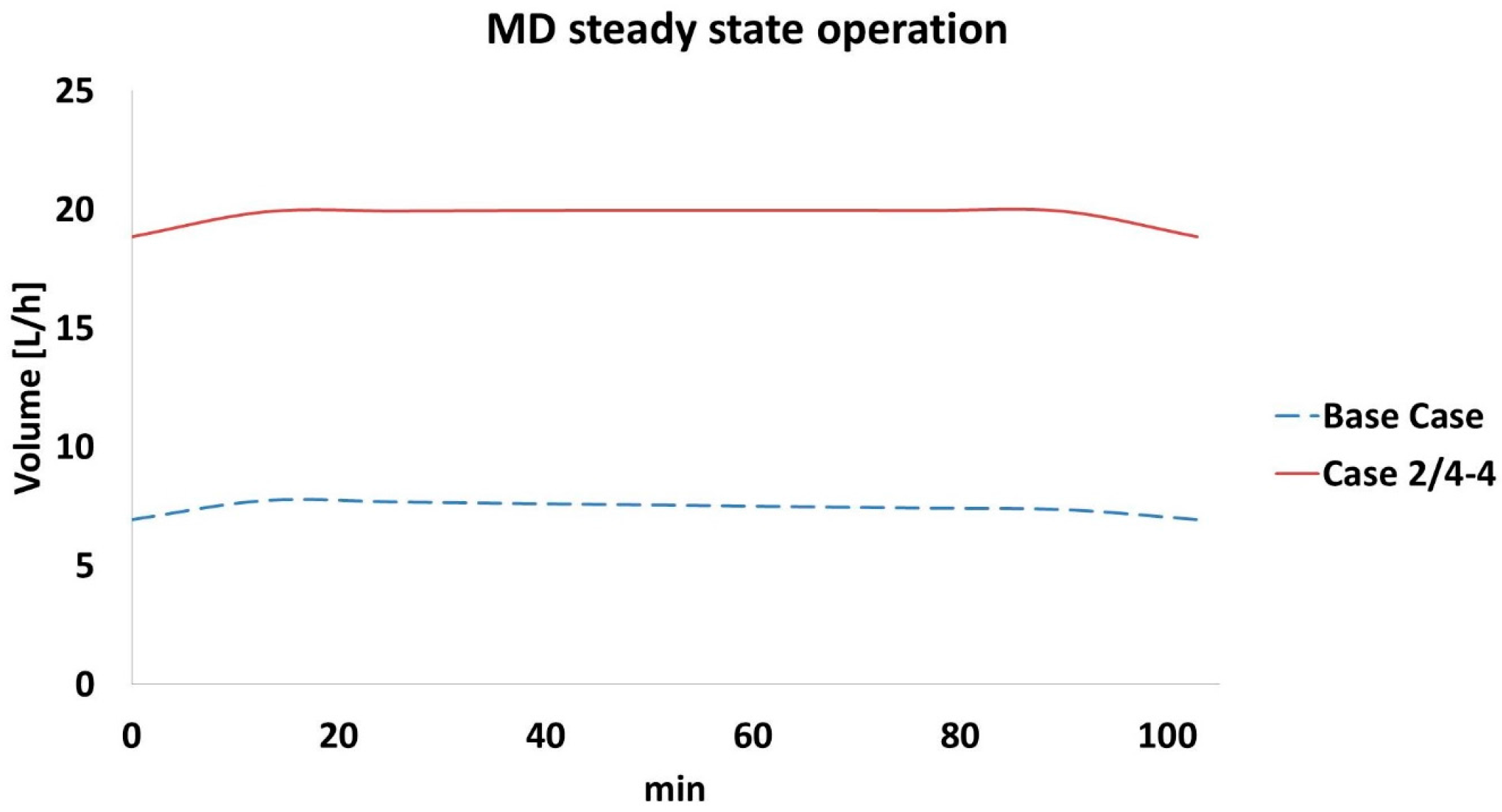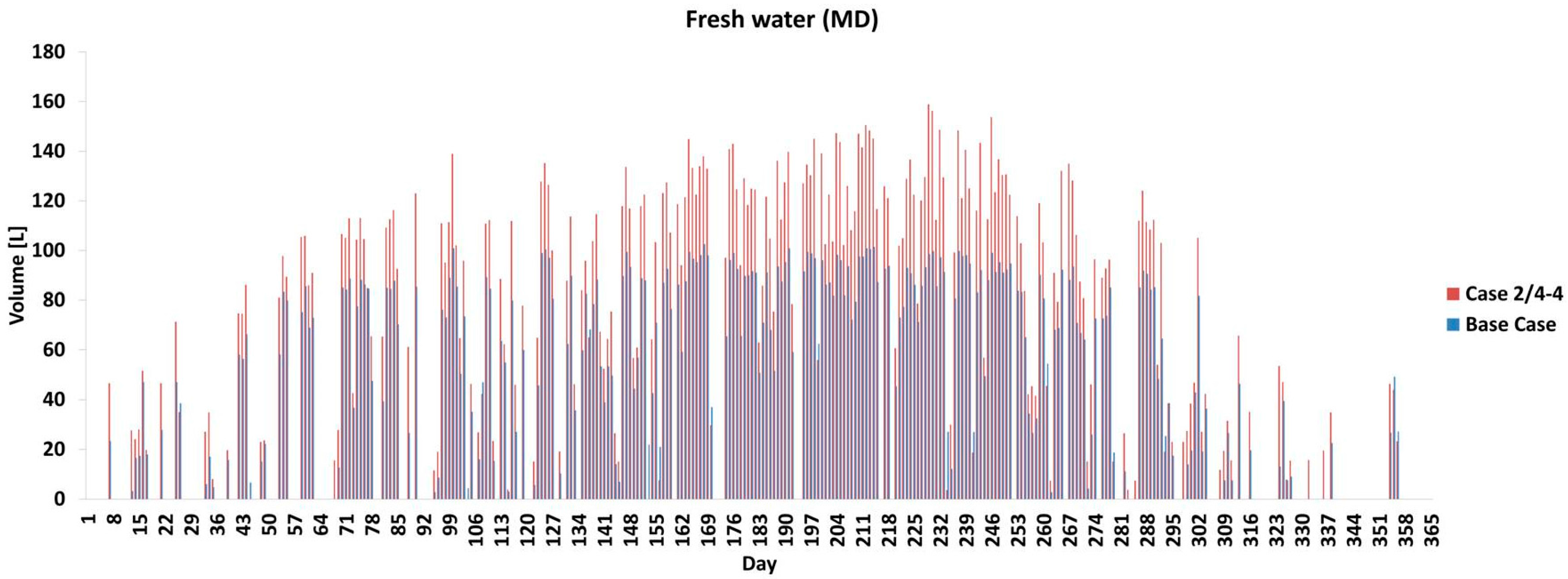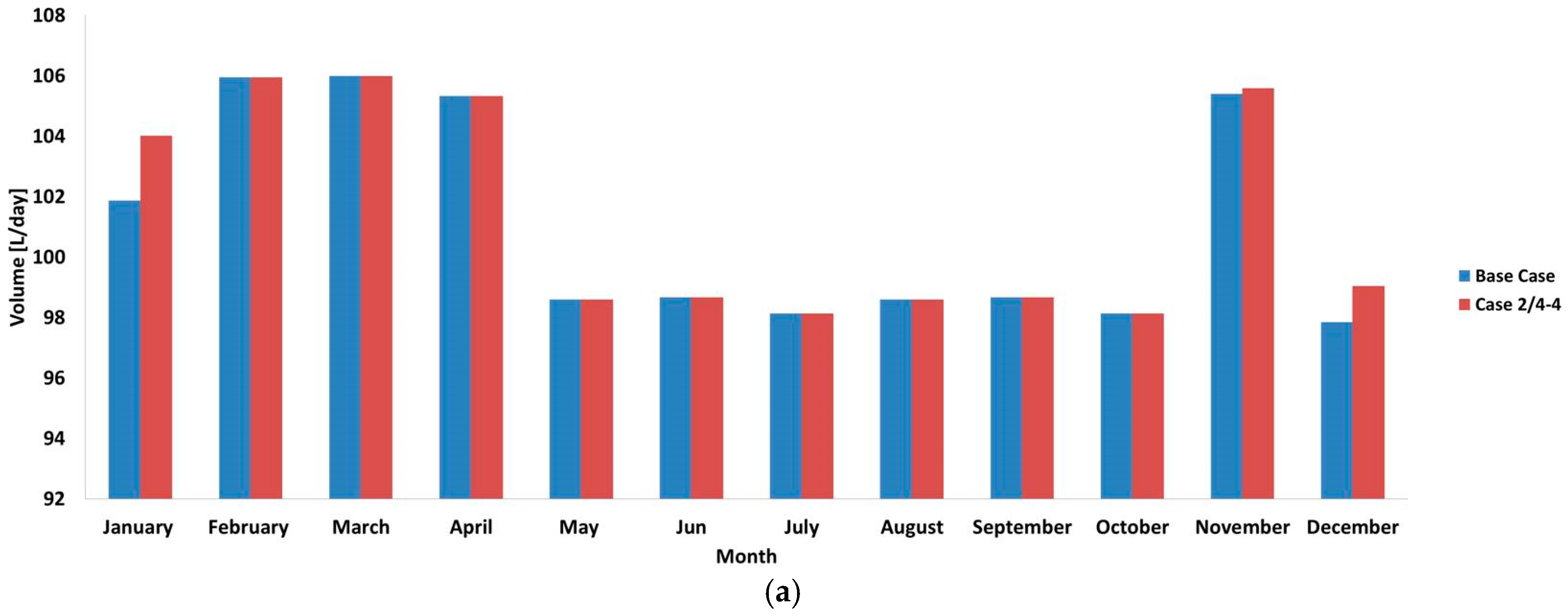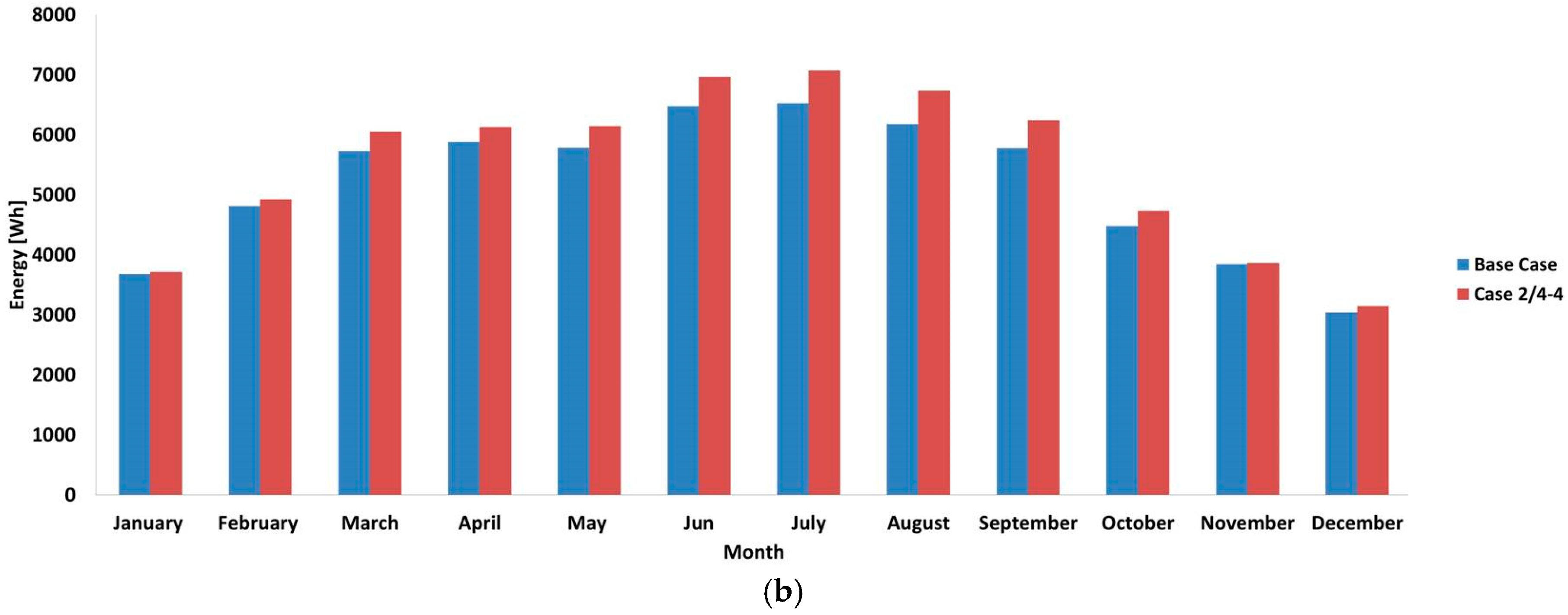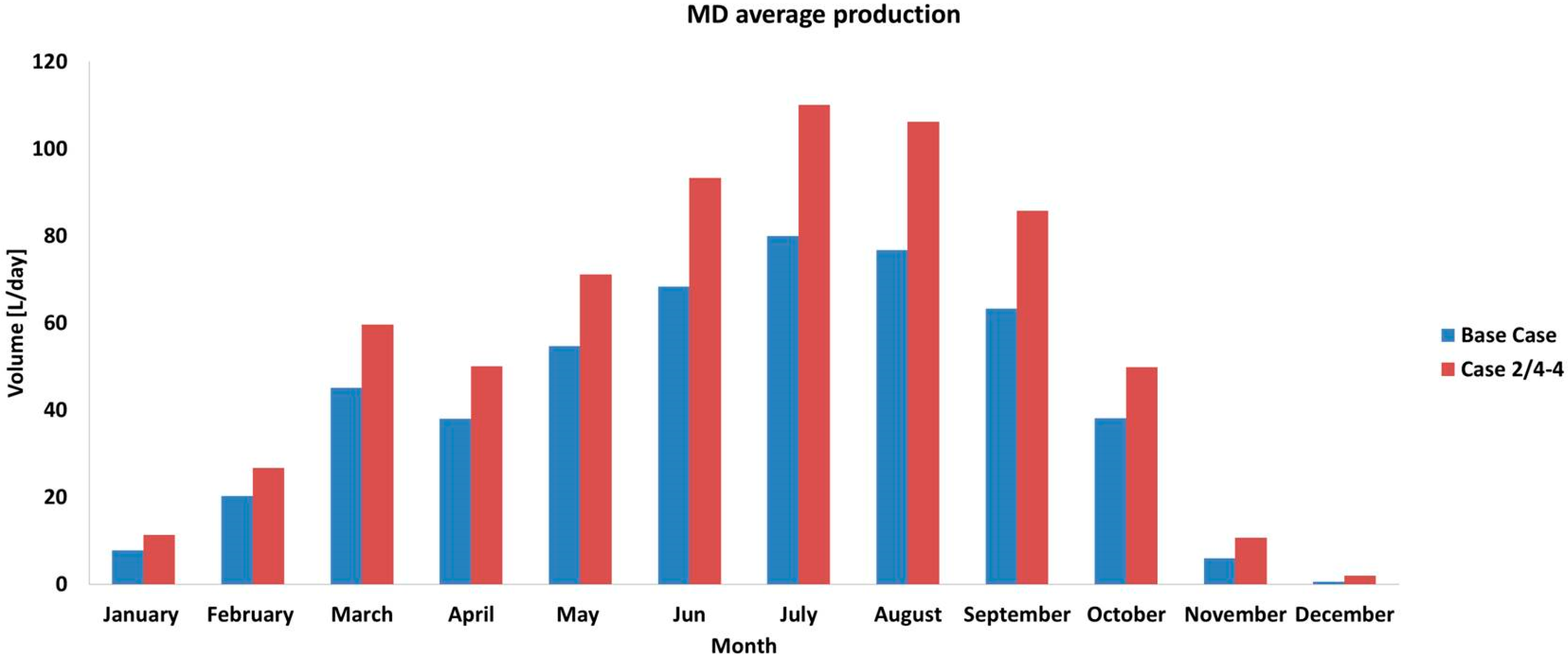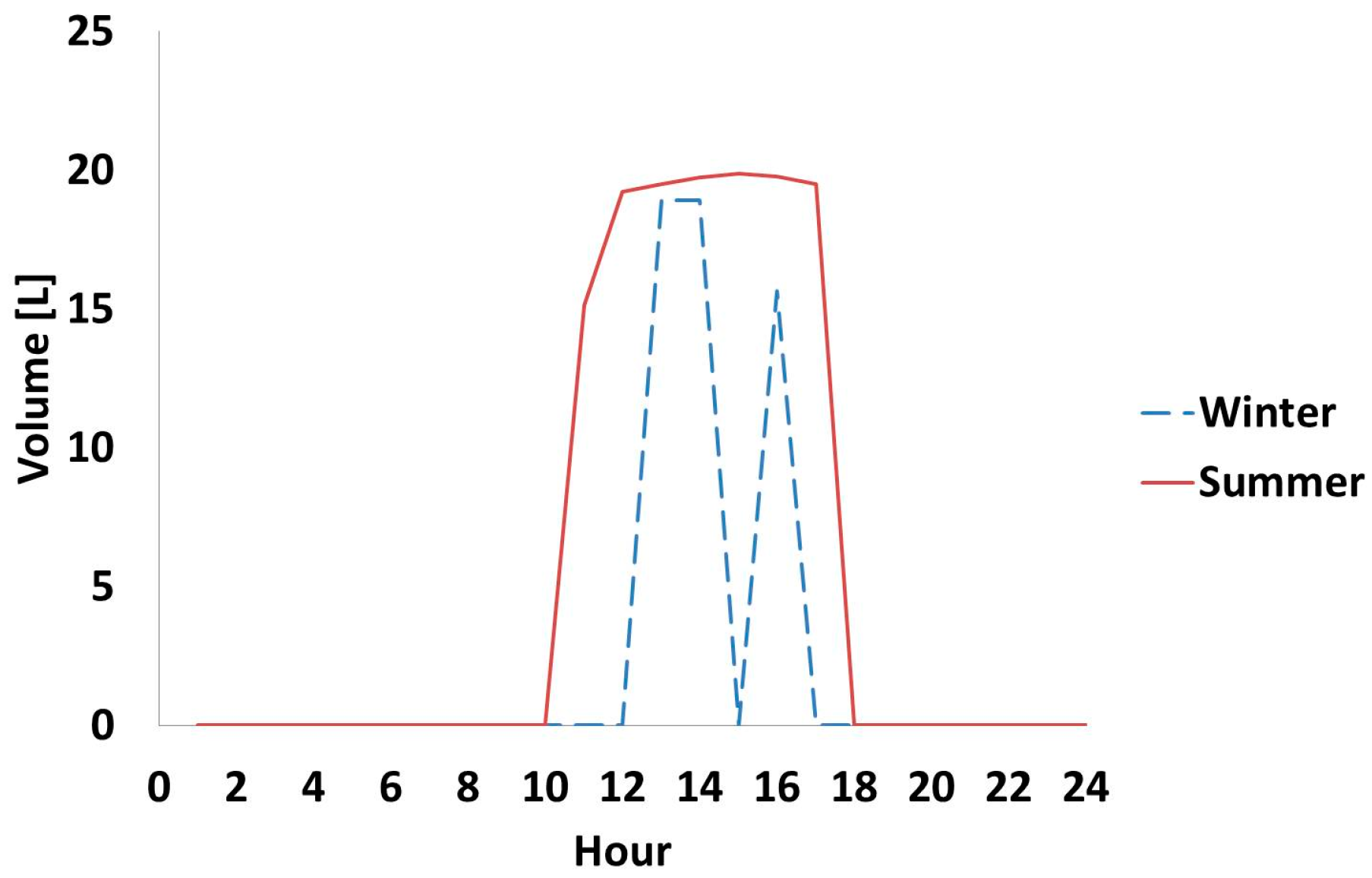1. Introduction
The need of safe-clean energy and water, especially in isolated areas in which power and water networks incur extra economic and environmental costs, is one of the challenges of the 21st century. The search for innovative and sustainable solutions to provide secure energy and water in isolated areas by integrating existing technologies is a reliable solution that should be explored. This paper is one attempt to solve this problem, providing a preliminary design for further implementation.
Nowadays, most of the energy produced around the world is obtained by burning fossil fuels. These kinds of fuels contribute to local air pollution, a significant decrease of woodlands around the world, ozone layer problems and higher temperatures around the whole planet [
1]. For that reason, it is important to use alternative energy resources like solar and wind energy which could be sustainable options when mainly thermal and electric energy are required to produce sanitary hot water (SHW) or even fresh water (FW) [
2].
In Europe, the solar thermal capacity is expected to reach about 150 to 250 GW by the year 2030, which would equate to a 7%–11% share of global electricity production [
3]. With solar energy, both electricity and thermal energy can be obtained through the use of a photovoltaic/thermal (PVT) collector [
4]. This hybrid collector integrates features of single photovoltaic and solar thermal systems in one combined product. The hybrid system basically consists of one absorbing plate to remove waste heat (cell cooling) from a photovoltaic panel (PV) through the circulation of a heat transfer fluid behind the PV cells [
5]. This hybrid arrangement reduces the overall temperature losses on the collector and increases the global efficiency. In other words, the solar energy that is not transformed into electricity is converted into thermal energy that can be partially recovered and used for different purposes, such as SHW generation [
6]. The electric efficiency of a single PV collector is about 10% to 20%, while a common thermal collector can harvest up to 60% with the same available surface. The combination of both systems (PVT) has an overall efficiency in the range of 40%–70% for unglazed and glazed panel designs. It has been demonstrated through an experiment that the electric efficiency of a PVT (glazed) system is about 6% while a single PV module under same conditions has 6.2% efficiency. However, if thermal energy is considered in the analysis, the global efficiency of the PVT can be increased up to 42% [
7]. Similar results were found in Avellino, Italy, where a PVT module was proved to be more efficient than a single PV system. Besides, it was demonstrated that due to the electricity and thermal energy production of the PVT, the economic savings are twice the economic savings achievable utilizing the single PV module [
8]. It should be noted that when a PVT operates at high thermal efficiency, the electric conversion is decreased. On the other hand, the PV cells do not allow heating the absorbing plate [
9]. Other factors that could improve the overall PVT efficiency are the number of covers, the shape of the absorber plate and the operative design configurations such as connections and the operating flow rate.
To improve the electricity generation, wind turbines (WTs) are able to transform the kinetic energy of the wind into mechanical energy and then to electricity [
10]. This kind of energy, as in the case of solar energy, is also free and widely available, does not pollute the environment (zero greenhouse emissions) and contributes to sustainable development [
11]. Usually, wind energy can be used for pumping water, street lighting or as standalone generating power system. Nevertheless, it strongly depends on unpredictable weather or climatic changes [
12].
Since it is not always is possible to have access to abundant wind or abundant solar irradiance, in isolated areas a wind-solar hybrid system is commonly utilized. In this way the electricity generated can greatly meet the load demand because one energy type can offset the shortfall of the other. For instance, during the day high solar irradiation and relatively low wind energy may occur, while by night the contrary occurs [
11,
12].
On the other hand, one of the major problems found in dry and/or isolated areas is water scarcity. The areas with the highest need of drinking water usually exhibit the highest solar energy availability [
13]. Since solar energy can supply almost unlimited energy, it can be an ideal solution for distilling water in isolated areas. Membrane distillation (MD) is a non-isothermal membrane separation process used in various applications such as desalination. The feed water (sea water) does not need chemical pre-treatments, it works at atmospheric pressure, operation is flexible (continuous or intermittent operation), the process can be carried out with temperatures between about 70 and 90 °C, and solar energy can also be utilized to produce distillate by heating seawater up to that range [
14]. The distillation process is based on the transport of vapor molecules through a hydrophobic micro-porous membrane [
15]. Due to tension forces at the membrane surface, liquid water and any other non-volatile components cannot pass through it. Heat supplied by an external (waste) source produces some vapor from the liquid state. The difference in temperature and pressure on both sides of the membrane is the driving force which leads to vapor passing through the membrane. Then, vapor is condensed by the aid of a coolant (normally a counter flow that preheats the MD feed water), and distillation process is completed. The vapor pressure difference across the membrane which drives the MD process can be established using different configurations [
16,
17,
18,
19]:
Direct contact membrane distillation (DCMD): is the simplest one. The membrane is in direct contact with both liquid phases (hot and cold).
Air gap membrane distillation (AGMD): To reduce heat losses, an air gap is set between the membrane and the condensation surface. Process energy efficiency is improved but reduced distillate flows are usually obtained.
Sweep gas membrane distillation (SGMD): Vapor is carried by a gas to an external condenser. It is usually applied to remove volatiles from the solution.
Vacuum membrane distillation (VMD): The permeate side remains at low pressures. In some cases, vapor is condensed at a separate device.
Permeate Gap Membrane Distillation (PGMD): Is similar to AGMD, but instead of using stagnant air, the condenser surface is full of water. The major advantage of PGMD is its energy efficiency, since an efficient heat recovery system [
20,
21] could be arranged.
The latter was the selected MD configuration for further modeling. Anyway, aside from the coincidence between water shortage and solar irradiation, and considering that MD is appropriate to be fed by solar energy for small capacities and isolated areas [
16,
22,
23,
24,
25], distillation techniques have usually higher energy consumptions than membrane techniques like reverse osmosis (RO) or electrodialysis (ED, for brackish waters), which only consume power. Of course, power to drive the high-pressure pump of a RO unit could also be obtained from a renewable source [
26], thus increasing the FW production in a hybrid scheme for seawater desalination. At present, RO processes use selective membranes which can retain most of the salt and microorganisms, leaving more than the 99% of the salts behind [
13].
The hybridization of Renewable Energy System (RES) technologies has been usually utilized to provide FW in remote and arid areas. For instance, in [
27] the design of a PV + WT coupled with a seawater RO unit including an energy recovery device (ERD) for a small island was generalized. In [
28], the same scheme (30.8 kW
p of PV + 600 W of WT) was modeled and analyzed for desalting brackish water with RO (40 m
3/day) at different locations in Tunisia. Experimental tests of the same arrangement in Israel (3.5 kW
p + 600 W) for an average production in the stand-alone brackish RO unit of 3 m
3/day, can be found in [
29]. If distillation units replace the RO, a multi-effect evaporator (MEE) supplied by solar and wind energy was also simulated and optimized depending on the solar collector area and system feasibility in Turkey [
30].
However, hybridization in desalination is usually restricted to larger facilities. Concentrating solar power (CSP) was analyzed in the framework of a medium-scale research and development (R + D) European Project [
31]. Produced steam was sent to a steam turbine (1 MW
e) that both supplied the RO system (800 m
3/day) and the MED (50 m
3/day) with the rejected steam. A back-up energy system (gas turbine, 1.25 MW
e) was also projected for cloudy days. For larger capacities, hybrid water desalination systems (MED + RO) supplied by conventional energy sources were optimized in [
32]. A steam network with several turbines at different pressure levels was analyzed for a combined production of up to 126,300 m
3/day. The same hybrid scheme supplied by a gas turbine (GT) and a combined cycle (CC) was also thermo-economically optimized in [
33].
Apart from producing energy and water with hybrid techniques and RES (cogeneration schemes), there are very few examples of tri-generation or poly-generation schemes involving seawater desalination and RES. In [
34,
35], a poly-generation system based on PVTs, a LiBr-H
2O chiller, and a MED distiller, with a back-up biomass heater was simulated and optimized in TRNSYS
® (
http://www.trnsys.com/) with weather data from Naples, Italy. A similar scheme could be optimized in its design and operation if conventional energy sources are neglected [
36].
From the previous analysis, it can be observed that the combination of hybrid techniques for both RES and desalination, which also includes SHW, has not been studied in detail yet. Thus, this paper presents the design analysis of a double hybrid scheme (wind/solar + MD/RO) which allows for providing power, SHW and FW at a much reduced demand scale in isolated areas. This hybridization is a technically possible solution and its profitability will depend on alternative costs to provide water and energy by a network or local transport.
Taking into account the variability of the renewable energy sources, a dynamic simulation is required in order to model and then to assess the performance of the transient processes occurring in that scheme. Dynamic simulation of this trigeneration scheme was performed in TRNSYS
® software (v16) [
37]. Its modular design easily permits to analyze main design parameters of each component but also the overall performance of the scheme proposed, according to the scheduled energy and water demands.
